NEETS Module 15 - Principles of Synchros, Servos, and Gyros
Pages i,
1-1,
1-11,
1-21,
1-31,
1-41,
1-51,
1-61,
1-71,
2-1,
2-11,
2-21,
2-31,
3-1,
3-11,
3-21,
4-1, Index
system to an open-loop configuration. At the same time, the deenergized contacts of K2 (1-3) open,
thereby breaking the closed loop. The open loop is shown by the medium density lines in the figure. This loop is
not as accurate as the closed loop, because the operator must intervene by turning the shaft of the potentiometer
back to the zero voltage position to stop the load at the desired position. This type of circuit could be used by
maintenance personnel to position the load for easy access to equipment, such as on an antenna or gun mount. The
open loop can also function as a basic velocity loop by simply not returning the potentiometer to the zero
position. This results in a constant error signal being present at the wiper arm of the potentiometer. With this
condition, the load will continue to drive at some speed (rate) determined by the components in the loop. The last
loop we will consider is the closed-loop velocity servo, indicated by the fine density lines. This loop is
switched into operation by energizing K1. Notice that there are two inputs to the summing network with
K1 energized, the electrical input through contacts 2-4 and the feedback from the tach through contacts
1-3. The two signals are compared in the summing network, and their difference is used as the error signal to
drive the load. When a state of equilibrium is reached in the circuit, the load will be moving at the desired
velocity.
Summary
This chapter has provided information basic to understanding servo systems and their components. The following
is a summary of specific points in the chapter. The OPEN-Loop CONTROL System is
controlled directly, and only by an input signal. It has no feedback and is therefore less accurate than the
closed-loop control system. The open-loop system usually requires an operator to control the speed and direction
of movement of the output.

The Closed-Loop CONTROL System is the most common type used in the Navy. It can respond and
move loads quickly and with greater accuracy than the open-loop system. The closed-loop system has an automatic
feedback system that informs the input that the desired movement has taken place.

2-31
The SERVO System is classified as a closed- loop system when it is capable of:
1. Accepting an order and defining the desired result, 2. Evaluating present conditions,
3. Comparing the desired result with present conditions and obtaining a difference or an error
signal, 4. Issuing a correcting order, and changing the existing conditions to the desired result,
and 5. Obeying the correcting order. The Basic SERVO System is normally
made up of electromechanical parts, and consists of a synchro-control system, servo amplifier, servo motor, and
some form of feedback. The POSITION SERVO has the goal of controlling the position of
the load. In the ac position servo system, the amplitude and phase of the ac error signal determine the amount and
direction the load will be driven. In the dc position servo system, the amplitude and polarity of the dc
error signal are used to determine the amount and direction the load will be driven.

The VELOCITY SERVO is based on the same principle of error-signal generation as the position
servo, except that the VELOCITY of the output is sensed rather than position of the load. When the velocity loop
is at correspondence, an error signal is still present, and the load is moving at the desired velocity.
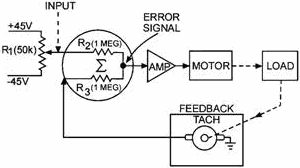
2-32
The ACCELERATION SERVO is similar to the velocity and position servos except that the
acceleration of the load is being sensed rather than the position or velocity. In this loop, the tachometer of the
velocity loop is replaced with an accelerometer. TIME LAG is a servo characteristic
defined as the time between the input of the signal and the actual movement of the load. Time lag is undesirable
and is reduced through the use of high-gain amplifiers. Damping systems are then added to attain smooth, efficient
operation.
An OVERDAMPED system will not be subject to oscillations but takes an excessive amount of time to
reach synchronization. An UNDERDAMPED system provides instant response to an error signal but results in the load
oscillating about the point of synchronism. Somewhere between overdamped and underdamped, designers achieve
adequate accuracy, smoothness, and a moderately short synchronizing time.
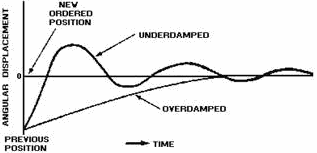
DAMPING is used to stabilize a system-to minimize or eliminate the problem of overshoot. The
simplest form of damping is FRICTION CLUTCH damping. Magnetic CLUTCH damping is similar to friction clutch
damping. The difference is in how the flywheel is coupled to the shaft of the servo motor. Magnetic coupling uses
a magnetic field to draw two friction plates together to produce damping. Another method uses the magnetic field
set up by a pair of coils or one coil in conjunction with a conducting surface (flywheel) to produce damping.
ERROR-RATE DAMPING is defined as a method of damping that "anticipates" the amount of
overshoot. This form of damping corrects the overshoot by introducing a voltage in the error detector that is
proportional to the rate of change of the error signal. The stabilization network used for error-rate damping
consists of either an RC differentiating network or an integrating network. The components of the RC network are
chosen to tailor the stabilization network to the requirements of the servo system.
2-33

Frequency Response of a servo is the range of frequencies to which the system is able to
respond in moving the load. The ideal system can respond to whatever frequencies are present in the input signal.
Frequency response is a good way of judging servo performance. In a given servo system, good frequency response
provides maximum stability and minimum time lag.
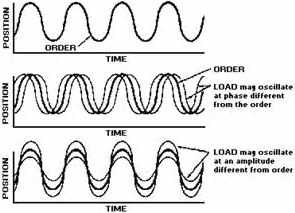
The Bandwidth of a servo amplifier, ideally, must be able to accept only the range of
frequencies that represent valid servo signals. Amplifier bandwidth is another compromise in achieving
optimum servo operation. A POTENTIOMETER is one of the simplest position sensor devices
and is generally used because of its small size, high accuracy, and output, which can be either ac or dc. Its
primary disadvantages are limited motion, limited life due to wear, and high torque required to rotate the wiper
contact.
a BALANCED POTENTIOMETER in a closed-loop servo system is a voltage divider that functions as a
position sensor and produces the error voltage that is fed to the servo amplifier.
2-34
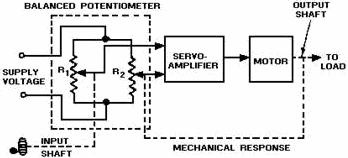
SUMMING NetworkS can be used as error detectors in servo systems to add algebraically two or
more inputs and a feedback error voltage.
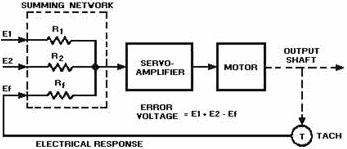
The E-Transformer is a magnetic error detector that can be used in systems limited by large
angular movements. Output signals are either in phase, 180º out of phase, or zero, depending on the direction of
the E-transformer's armature motion. The amplitude of the signal is determined by the amount of armature motion.
The basic E-transformer can only detect motion in one axis.
2-35
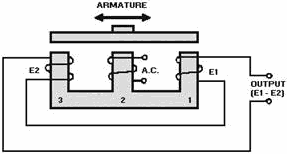
A CROSSED-E Transformer (or pickoff) is two E-transformers placed at right angles to each
other. This type of error detector is capable of detecting error in both horizontal and vertical directions.
a CONTROL Transformer (CT), when used as a magnetic error detector, can rotate through unlimited
angles. The output of this type of CT is always an ac servo error signal that must be demodulated if it is used
with a dc servo motor. A RATE GENERATOR (tachometer), when used in the velocity servo
loop, is the heart of the feedback loop. The tach senses velocity (speed) of the load. a tachometer can be either
an ac or dc rate generator. The output frequency of the ac tach is the same as the reference frequency, varying
only in phase depending on the direction of rotation.
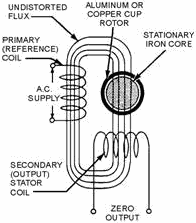
ModulatorS are used to change a dc error signal into an ac input error signal for servo
amplifiers. This device is required when ac servo amplifiers are used instead of dc amplifiers.
2-36
DEModulatorS convert ac error signals to dc error signals. The dc signal is required
to drive a dc servo amplifier. A SERVO Amplifier used in an ac or dc servo system must
have a flat gain, minimum phase shift, low output impedance, and low noise level. AC SERVO MOTORS
are used in servo systems that move light loads. Large ac motors are too inefficient for servo use when large
loads are to be moved. DC SERVO MOTORS can control heavy loads, and are widely used in
servo systems. The speed and direction of the dc servo motor can be varied easily by varying the armature current.
Magnetic AmplifierS are used when power from a conventional servo amplifier is too small to drive
large servo motors (either ac or dc). The MULTI-Loop SERVO System combines several
closed and/or open servo loops together to control a common load.
Answers to Questions Q1. Through Q25.
A-1. a system in which the precise movement of a large load is controlled by a relatively weak
control signal. A-2. Usually the operator senses the desired load movement and reduces the
input to stop the motor. A-3. Feedback. A-4. Input signal and feedback.
A-5. To move the load and provide feedback data to the error detector. A-6.
Classifications in accordance with position, velocity, and acceleration functions. A-7. Amount
and direction of rotation. A-8. Hunting. A-9. Velocity loop senses
velocity rather than position. When velocity loop is nulled, an error signal is still present and the load
continues to move.
A-10. Tachometer. A-11. The closed-servo loop can regulate load speed under
changing conditions. A-12. Underdamped. A-13. Overdamped. A-14.
To minimize overshoot and/or oscillations. A-15. Anticipating. A-16. It
should oscillate.
2-37
A-17. Unwanted noise-generated frequencies are rejected. A-18. Zero.
A-19. (a) Phase. (b) Amplitude. A-20. E-transformer and control transformers.
A-21. The method of primary excitation (ac and permanent magnet). A-22. To convert
a dc error signal into an ac error signal. A-23. To convert an ac error signal into a dc error
signal. A-24. To switch control of the amplifier between either the coarse signal and the fine
error signal. A-25. Two saturable reactors and a transformer.
2-38
| - |
Matter, Energy,
and Direct Current |
| - |
Alternating Current and Transformers |
| - |
Circuit Protection, Control, and Measurement |
| - |
Electrical Conductors, Wiring Techniques,
and Schematic Reading |
| - |
Generators and Motors |
| - |
Electronic Emission, Tubes, and Power Supplies |
| - |
Solid-State Devices and Power Supplies |
| - |
Amplifiers |
| - |
Wave-Generation and Wave-Shaping Circuits |
| - |
Wave Propagation, Transmission Lines, and
Antennas |
| - |
Microwave Principles |
| - |
Modulation Principles |
| - |
Introduction to Number Systems and Logic Circuits |
| - |
- Introduction to Microelectronics |
| - |
Principles of Synchros, Servos, and Gyros |
| - |
Introduction to Test Equipment |
| - |
Radio-Frequency Communications Principles |
| - |
Radar Principles |
| - |
The Technician's Handbook, Master Glossary |
| - |
Test Methods and Practices |
| - |
Introduction to Digital Computers |
| - |
Magnetic Recording |
| - |
Introduction to Fiber Optics |
| Note: Navy Electricity and Electronics Training
Series (NEETS) content is U.S. Navy property in the public domain. |
|



















